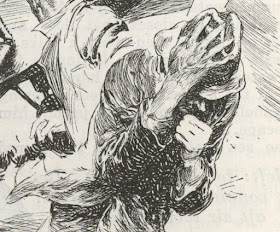In 1948, Ben Shahn illustrated an article for
Harpers Magazine about the murder trial of James Hickman.
Hickman worked the night shift in a Chicago steel mill to support his wife and seven children. The family lived in a tiny attic in a tenement slum, in one of the few neighborhoods where African Americans were permitted to live under Chicago's racially restrictive zoning rules. Hickman wanted to move out of his apartment but his landlord refused to return Hickman's security deposit. The landlord warned tenants that if they raised problems, he knew "a man" who would come burn them out of their homes.
On the night of January 16, 1947, Hickman was working at the mill when his apartment caught fire. The apartment was unsafe, with no exits, fire escapes or extinguishers. His children were trapped inside. When he returned the next morning his neighbor said, "Mr. Hickman, I hate to tell you this, four of your children is burnt to death." They found the body of Hickman's 14 year old son under the bed, futilely trying to shield three of his younger siblings from the flames.
The Chicago police made no serious effort to investigate the landlord. As months went by, the anguished Hickman, devoutly religious, obsessed more and more about the babies that he'd lost, and the lack of justice in the world. He muttered to himself, "Someday they would have married, someday they would have been fathers and mothers of children...."
Eventually Hickman got a gun. Following God's instructions, he killed the landlord. For the first time, the Chicago police felt motivated. They promptly arrested Hickman who freely admitted what he'd done, saying, "Paper was made to burn, coal and rags, not people. People wasn't made to burn."
The prosecutor charged Hickman with first degree murder. He was surely headed for the gallows, but then the story took an unusual bounce. The other tenants in Hickman's building angrily organized into the Chicago Area Tenant's Union and combined with the Congress for Racial Equality (CORE) to publicize the case and support Hickman. An outraged public rose up. The ACLU defended Hickman and the jury refused to convict him.
Harpers Magazine hired the distinguished journalist John Bartlow Martin to write about the trial, and renowned artist Ben Shahn to illustrate the story. Shahn remained haunted by what he had learned about the case, and after completing the illustrations, he went on to create a larger, more allegorical painting about the tragedy. Shahn transformed the fire into a flaming wolf / lion creature, with the children lying dead at his feet.
Unfortunately, some officials-- already suspicious of Shahn's support for racial equality-- became concerned that the red beast might symbolize communism. Henry McBride, writing for the
New York Sun, argued that Shahn should be "deported" for his "pro-communist painting."
Shahn was indeed a socially conscious artist; he had previously participated in the
WPA, where he worked with other artists who were interested in creating an American art that reflected the lives of ordinary people. The following image, by another WPA artist, gives us insight into crowded urban life in the '30s for people of that class.
One critic noted that after the social injustice of the Great Depression and the existential threat of World War II had subsided, former WPA artists became less interested in a representational, humanistic style:
Artists had to apply for WPA positions. They were paid between $23 and $35 a month to produce a set amount of work every week. "There were a lot of women participants... and it was very overtly welcoming to African-Americans....." Perhaps because there was so much collaboration-- or because the artists wanted to keep their patron, the WPA, happy-- most of the prints remained representational and accessible.... "very focused on the present and engagement with the human experience.... The WPA officially disbanded in 1942, although artists continued to work in that style through Word War II. But after the war, notions of art changed. "The project developed a national identity that pulls away from the personal....After the war, artists reacted against it with abstract expressionism....It was a natural pendulum swing, I think, a reaction to the ways the WPA didn't speak to individual artists."
Since the post war era, much of fine art has been self-absorbed and self-referential. But it appears that there may be many opportunities for artists to play a socially conscious role in the years ahead. It will be interesting to see how the art community responds.
_________________________
PS-- In 1948 the Supreme Court finally ruled that the racially restrictive covenants which had kept Hickman and other African-Americans confined to a narrow stretch of dilapidated, rat infested apartments were unconstitutional. Here's hoping that the new appointments to the Court don't have a change of heart.



















































